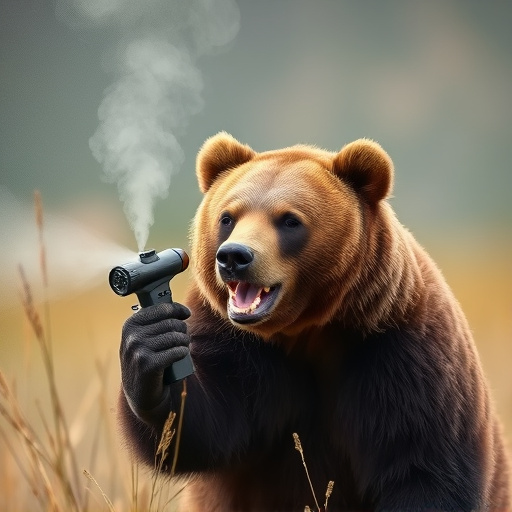Understanding bear behavior and practicing responsible hiking habits are essential for safe adventures in North America's bear country. Bear spray, a crucial deterrent, should be used correctly, aiming at bears' faces from 20-30 feet away upon activation, while hikers quickly move away at a right angle to create a barrier. Minimizing water runoff from gear and proper hydration reduce attractants for bears, enhancing safety in areas where bear spray usage is vital for deterring close encounters without dilution from surrounding water bodies.
Exploring nature’s wonders in bear country? Equip yourself for a safe adventure with our comprehensive guide. We delve into understanding bear behavior, essential safety gear, and effective use of bear spray. Learn vital techniques to navigate risky waters and minimize Bear Spray runoff, ensuring a responsible and memorable hike. Stay informed, stay safe – because your preparation is the key to coexisting harmoniously in these wild habitats.
- Understanding Bear Behavior and Their Habitat
- Essential Safety Gear for Hiking in Bear Country
- Effective Use of Bear Spray: Techniques and Tips
- Staying Safe Near Water Sources in Bear-Inhabited Areas
Understanding Bear Behavior and Their Habitat
Understanding bear behavior is a crucial aspect of hiking in bear country. Bears are wild animals with complex habits and instincts, which can vary depending on the species and their environment. In North America, for instance, black bears and grizzly bears (a sub-species of brown bears) are commonly encountered by hikers. These bears are primarily herbivorous, feeding on plants, berries, and nuts, but they can also be attracted to human food sources due to runoff water from campsites or picnic areas. This behavior can lead to conflicts if bears associate humans with an easy source of food.
When hiking in bear country, it’s essential to respect their habitat and take precautions to avoid surprising them. Bears are generally cautious of humans and will usually avoid encounters unless they feel threatened or are protecting their young. Using bear spray, a powerful deterrent that creates a temporary but effective barrier between you and the bear, can help prevent aggressive interactions. Proper storage and application techniques for bear spray are key, as runoff water from bodies of water nearby could impact its effectiveness. Always follow local guidelines and stay informed about bear activity in your chosen hiking area to ensure both your safety and the preservation of these magnificent creatures’ natural behavior and habitat.
Essential Safety Gear for Hiking in Bear Country
When venturing into bear country, proper preparation is key to a safe and enjoyable hike. Essential safety gear includes a reliable bear spray, designed to create a barrier between you and potential bears. This repellent should be easily accessible, and it’s crucial to familiarize yourself with its usage before setting out. Bear spray is an effective deterrent when used correctly, creating a temporary haze that can disrupt a bear’s behavior.
Additionally, staying hydrated is vital for your safety and overall experience. Always carry enough water, as staying properly hydrated can reduce the risk of encounters with bears due to reduced aggression caused by dehydration. Keep your water sources secure and consider using a refillable bottle with a straw to minimize runoff, which can attract wildlife. Remember, being prepared with the right gear is your best defense when hiking in bear country.
Effective Use of Bear Spray: Techniques and Tips
Bear spray is a critical component of hiking safety in bear country. To be effective, it’s crucial to understand how and when to use it. The key lies in proper technique and avoiding runoff water safety issues.
First, ensure you hold the can upright, aiming at the bear’s face from about 20-30 feet away. Spraying too close may result in mist hitting you, while spraying too far might not reach the bear effectively. Once triggered, move away quickly at a right angle to the bear’s path—don’t turn your back on it. This creates a barrier between you and the bear as the spray dissipates, providing precious time to escape. Remember, practice these techniques before venturing into bear country to ensure confidence and effectiveness in an actual encounter.
Staying Safe Near Water Sources in Bear-Inhabited Areas
When hiking in areas inhabited by bears, it’s crucial to understand that water sources can pose unique risks. While bears are often attracted to rivers and streams for drinking and fishing, they may also be defensive if their food source is disturbed or if they feel threatened. Bear spray, a common piece of safety equipment, is designed to deter bears when used correctly. It works by creating a barrier of scent that temporarily disorients the bear, allowing you to escape. Remember, bear spray is most effective at close range, so keep it readily accessible and ensure all group members know how to use it.
To enhance water safety, practice responsible behavior near rivers and lakes. Avoid bringing food or strong-smelling items into these areas, as they can attract bears. Always make noise while walking along water sources to avoid startling a bear from its den or resting spot. If you encounter a bear at a water source, remain calm, back away slowly, and leave the area immediately, ensuring no runoff from your body or gear attracts their attention.
When hiking in areas inhabited by bears, it’s crucial to be prepared and respect their natural habitat. By understanding bear behavior, equipping yourself with essential safety gear like reliable bear spray, and adhering to safe practices near water sources, hikers can significantly reduce potential risks. Remember, knowledge and proper preparation are key to a safe and enjoyable outdoor experience in bear country. Always stay alert, follow local guidelines, and ensure your actions minimize the impact on these majestic creatures and their environment.
